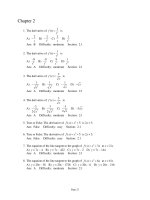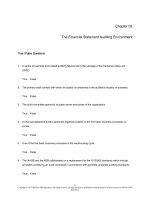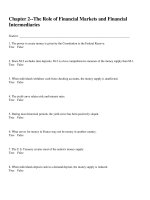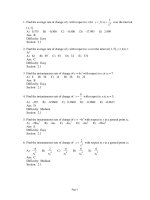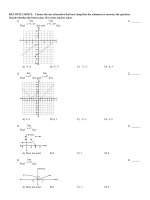Calculus and its applications 10th edition bittinger test bank
Bạn đang xem bản rút gọn của tài liệu. Xem và tải ngay bản đầy đủ của tài liệu tại đây (3.27 MB, 65 trang )
MULTIPLE CHOICE. Choose the one alternative that best completes the statement or answers the question.
Decide whether the limit exists. If it exists, find its value.
1)
1) _______
Find
f(x) and
A) -5; -2
f(x).
B) -7; -5
C) -7; -2
D) -2; -7
2)
2) _______
Find
f(x) and
A) 3; -1
f(x).
B) 3; 1
C) - 3; -1
D) -1; 3
3)
3) _______
Find
f(x).
A) Does not exist
B) 2
C) 1
D) 0
4)
4) _______
Find
f(x).
A) Does not exist
B) 1
C) -1
D) 0
5)
5) _______
Find
f(x).
A) -1
B) 0
C) -2
D) Does not exist
6)
6) _______
Find
f(x).
B) -2
A) 2
C) Does not exist
D) 0
7)
7) _______
Find
f(x).
A)
B) Does not exist
C) 0
D) 1
8)
8) _______
Find
f(x).
B) -1
A) 0
9)
Find
f(x).
C) 1
D) Does not exist
9)
_______
A) Does not exist
B) 0
C) -2
D) -1
10)
10) ______
Find
A) -1
f(x).
B) Does not exist
C) 0
Use the graph to determine whether each statement is true or false.
11)
A) True
11) ______
B) False
12)
12) ______
A) False
13)
D) -2
B) True
13)
___
___
A) False
B) True
14)
14) ______
f(x) = 2
A) True
B) False
15)
15) ______
A) True
16)
B) False
16)
______
A) True
B) False
17)
17) ______
A) True
B) False
18)
18) ______
A) True
B) False
19)
19) ______
A) True
20)
B) False
20)
___
___
A) False
B) True
Graph the function and then find the specified limit. When necessary, state that the limit does not exist.
21)
f(x) =
;
f(x)
A)
B)
f(x) = 3
C)
f(x) = 0
D)
f(x) = 7
21) ______
f(x) = 2
22)
22) ______
f(x) =
;
A)
f(x)
B)
f(x) = 0
C)
f(x) = 5
D)
f(x) = 5
f(x) = -5
23)
23) ______
f(x) =
;
f(x)
A)
B)
f(x) = 0
C)
D)
f(x) = 0
24)
f(x) = -4
f(x) does not exist
;
f(x)
f(x) does not exist
24)
___
___
A)
B)
f(x) = -4
C)
f(x) = 4
D)
f(x) = 0
25)
f(x) = 0
25) ______
y = x2 - 5;
f(x)
A)
B)
f(x) = -5
f(x) = 5
C)
D)
f(x) = -5
f(x) = 5
26)
26) ______
f(x) =
;
A)
f(x) = 5
f(x)
B)
f(x
)=
5
C)
D)
f(x) = 1
f(x) = -3
27)
27) ______
y(x) =
;
A)
f(x) does not exist
f(x)
B)
f(x
)=
9
C)
D)
f(x) = -4
f(x) does not exist
28)
28) ______
f(x) =
;
A)
f(x) = 4
f(x)
B)
f(x
)=
3
C)
D)
f(x) does not exist
29)
f(x) = 3
29) ______
y=
- 2;
f(x)
A)
f(x) = -2
B)
f(x
)=
2
C)
D)
f(x) = 0
f(x) = 0
Solve the problem.
30) Given is a graph of a portion of the postage function, which depicts the cost (in cents) of mailing
a letter, p, versus the weight (in ounces) of the letter, x. Find each limit, if it exists:
p(x),
p(x),
p(x)
30) ______
A) 77; 99; 77
C) 99; 77; does not exist
B) 77; 99; does not exist
D) 77; 77; 77
31) Given is a graph of a portion of the postage function, which depicts the cost (in cents) of mailing
a letter, p, versus the weight (in ounces) of the letter, x. What is the postage for a letter weighing
31) ______
Is the postage function continuous?
A) 55 cents; 55 cents; 77 cents; no
C) 55 cents; 77 cents; 77 cents; no
B) 33 cents; 55 cents; 77 cents; no
D) 55 cents; 55 cents; 77 cents; yes
32) Suppose that the cost, p, of shipping a 3-pound parcel depends on the distance shipped, x,
according to the function p(x) depicted in the graph. Is p continuous at
at
32) ______
at
at
A) No; no; yes; no
C) Yes; no; no; no
B) Yes; yes; yes; no
D) Yes; no; yes; no
33) Suppose that the cost, p, of shipping a 3-pound parcel depends on the distance shipped, x,
according to the function p(x) depicted in the graph. Find each limit, if it exists:
p(x),
p(x),
p(x)
33)
______
A) 5; 10; 15
C) 5; does not exist; does not exist
B) 5; does not exist; 15
D) 5; 5; 15
34) Suppose that the cost, C, of producing x units of a product can be illustrated by the given graph.
Find each limit, if it exists:
p(x),
p(x),
p(x)
A) 200; 300; does not exist
C) 200; 300; 200
B) 200; 200; 200
D) 200; does not exist; does not exist
35) Suppose that the cost, C, of producing x units of a product can be illustrated by the given graph.
Is
34) ______
35) ______
continuous at
A) Yes; yes; yes
B) No; no; no
C) Yes; no; no
D) Yes; no; yes
36) Suppose that the unit price, p, for x units of a product can be illustrated by the given graph. Find
each limit, if it exists:
p(x),
p(x),
p(x),
p(x)
36)
______
A) 8; 8; does not exist; 8
C) 10; 8; does not exist; 8
B) 8; 8; 8; 8
D) 10; 8; 8; 8
37) Suppose that the unit price, p, for x units of a product can be illustrated by the given graph. Is p
37) ______
continuous at
A) No; no; no
B) No; yes; no
C) Yes; no; yes
D) No; yes; yes
38) Consider the learning curve defined in the graph. Depicted is the accuracy, p, expressed as a
percentage, in performing a series of short tasks versus the accumulated amount of time spent
practicing the tasks, t. Is
A) Yes; yes; yes
continuous at
B) Yes; no; yes
at
at
C) Yes; no; no
D) No; no; no
39) Consider the learning curve defined in the graph. Depicted is the accuracy, p, expressed as a
percentage, in performing a series of short tasks versus the accumulated amount of time spent
practicing the tasks, t. Find each limit, if it exists:
p(x),
p(x),
p(x)
38) ______
39)
______
A) 40; 100; 100
C) 100; 100; 100
B) 40; 100; does not exist
D) 40; 40; 40
Find the limit, if it exists.
40)
(8x + 8)
A) -40
40) ______
B) 16
C) 8
D) 56
41)
41) ______
(
A) 0
+ 8x - 2)
(
A) 0
- 5)
B) Does not exist
C) -18
D) 18
42)
42) ______
B) Does not exist
C) -5
D) 5
43)
43) ______
( +5
- 7x + 1)
A) Does not exist
B) 0
C) 15
D) 29
44)
44) ______
(2
A) 63
-2
+4
+
- 5)
B) -1
C) 127
D) 31
45)
45) ______
A) Does not exist
B) 2
C) 4
D) 0
46)
46) ______
A) 14
B) 0
C) 1
D) Does not exist
In the exercise below, the initial substitution of x = a yields the form 0/0. Look for ways to simplify the function
algebraically, or use a table and/or graph to determine the limit. When necessary, state that the limit does not exist.
47)
47) ______
A) Does not exist
B) 1
C) 7
D) 14
48)
48) ______
A) -16
B) -8
C) 1
D) Does not exist
49)
49) ______
A) - 3
B) Does not exist
50)
C) 4
D) 0
50) ______
A)
-
B)
C)
D)
-
51)
51) ______
A) -3
B)
C)
D) 3
-
52)
52) ______
A) - 6
B) -12
C) 12
D) 6
53)
53) ______
A) -8
B) 8
C) -4
D) 16
54)
54) ______
A) 0
Find the limit, if it exists.
55)
-2
A) 2
B)
C) 7
D)
55) ______
B) 0
C) -2
D) Does not exist
56)
56) ______
A) ±14
B) Does not exist
C) 196
D) 14
57)
57) ______
A) -1
B) Does not exist
C) 1
D) 0
58)
58) ______
A) Does not exist
B) ±
C) 93.5
D)
59)
59) ______
A) 0
B) Does not exist
C) 3.5
Determine whether the function shown is continuous over the interval (-5, 5).
60)
D) 7
60)
A) Yes
___
___
B) No
61)
61) ______
A) Yes
B) No
62)
62) ______
A) Yes
63)
B) No
63)
A) Yes
___
___
B) No
64)
64) ______
A) Yes
B) No
65)
65) ______
A) Yes
66)
B) No
66)
A) Yes
___
___
B) No
67)
67) ______
A) Yes
B) No
68)
68) ______
A) Yes
Use the graph to answer the question.
69) Is f continuous at x = 1?
B) No
69)
A) Yes
___
___
B) No
70) Is f continuous at x = 1?
A) No
70) ______
B) Yes
71) Is f continuous at x = -1?
A) Yes
72) Is f continuous at x = 3?
71) ______
B) No
72)
A) Yes
___
___
B) No
73) Is f continuous at x = 0?
A) Yes
73) ______
B) No
74) Is f continuous at x = 4?
A) No
75) Is f continuous at x = 0?
74) ______
B) Yes
75)
___
___
A) Yes
B) No
76) Is f continuous at x = -1?
76) ______
A) Yes
B) No
77) Is f continuous at x = 2?
77) ______
A) Yes
B) No
Evaluate or determine that the limit does not exist for each of the limits
and
for the given function f and number d.
78)
78) ______
f(x) =
; d = -1


